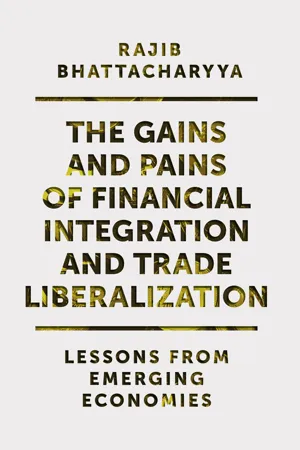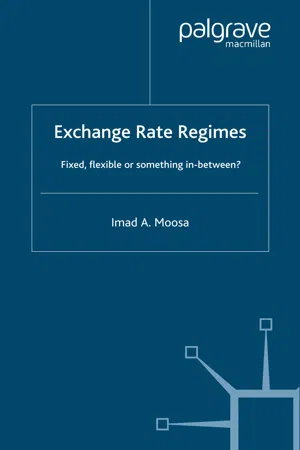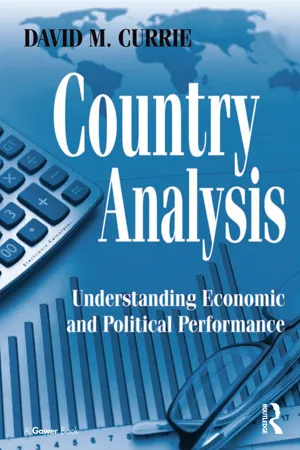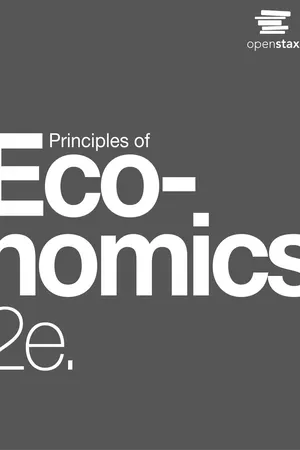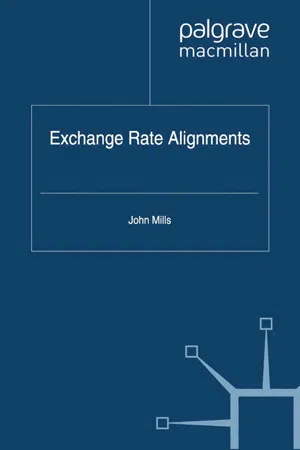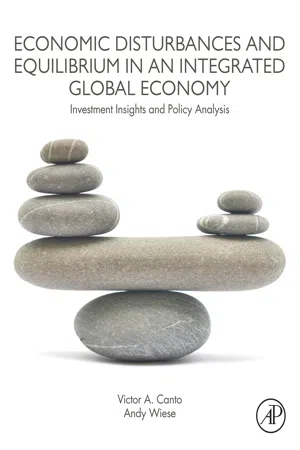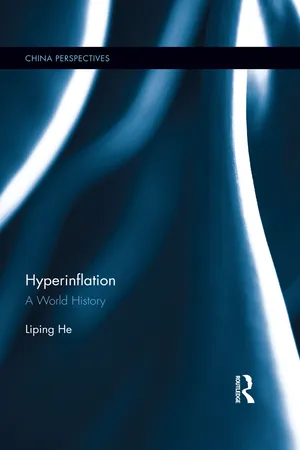Economics
Exchange Rate and Inflation
Exchange rate and inflation are interconnected in the economy. When a country's currency depreciates, imports become more expensive, leading to higher inflation. Conversely, a stronger currency can lower inflation by making imports cheaper. Exchange rate movements can impact inflation through their effects on the prices of imported goods and services, influencing a country's overall price level.
Written by Perlego with AI-assistance
Related key terms
1 of 5
12 Key excerpts on "Exchange Rate and Inflation"
- eBook - ePub
The Gains and Pains of Financial Integration and Trade Liberalization
Lessons from Emerging Economies
- Rajib Bhattacharyya(Author)
- 2019(Publication Date)
- Emerald Publishing Limited(Publisher)
2016) for details). This is particularly true post 2008–2009, where we can decipher that high values of exchange rate are congruent with high inflation rate and low growth rate of GDP. Especially, post 2009–2010, while exchange rate started heading northward, GDP growth rate marched southward. On the other hand, both CPI inflation and exchange rate went hand in hand, on an upward trajectory (on an average).Fig. 14.1.Indian Growth, Inflation, and Exchange Rate.Source: RBI, Author's Calculations.Investment, trade, and capital flow channels are the routes through which India's growth rate is affected. Let us explain. First, India's major driver of growth has been investment, which is highly dependent on import of oil, capital, and intermediate good, and thus, exchange rate. A rise in exchange rate (fall in R/$ rate) raises profitability of investment by reducing the cost of import as well as raises the net worth of firms and reduces the latter's external finance premium. Further debt of firms (serviceable in terms of domestic goods) also affects investment adversely. A rise in exchange rate increases value of debt in terms of domestic currency (and also in real terms), adversely affecting investment. Thus, low exchange rate is a beneficial factor for high growth. Secondly, India's exports are highly import-intensive (like import of oil, gems, raw materials, chemicals, capital goods, etc.). Therefore, a rise in exchange rate does not lead to much improvement in the net export of the country. Let us elaborate. A rise in exchange rate makes imports costlier. Since a rise in cost of imports feeds into the price of exports by raising it, it raises costs of imports for foreign countries, thereby not leading to a sufficient rise in exports. Finally, a rise in exchange rate feeds into the domestic price level (though imperfectly) and reduces real value of money holding or wealth, reducing consumption (through real balance effect) and hence, aggregate demand. From Fig. 14.1 - eBook - PDF
Exchange Rate Regimes
Fixed, Flexible or Something in Between?
- I. Moosa(Author)
- 2006(Publication Date)
- Palgrave Macmillan(Publisher)
employment (or output) and inflation as its components. Policy-makers would like to have high employment and output and low inflation, but complications are introduced by the fact that there may be a trade-off between these sub-targets (as implied by the Phillips curve). Exchange rate regimes/policies affect the internal balance because the price of a currency has an important direct influence on the general price level (as we have seen), and an important indirect influence on the level of aggregate economic activity. Microeconomic efficiency, or the efficiency of resource allocation, is important for the objective of maximizing real income. Exchange rate regimes/policies affect efficiency in two ways: (i) by affecting the uncertainty surrounding the outcome of economic transactions (particularly foreign-trade transactions), and (ii) by making the imposition of trade restrictions more or less likely. Exchange rate fluctuations as a source of risk and uncertainty Some cynical commentators say that the shift from fixed to flexible exchange rates following the collapse of the Bretton Woods system in the early 1970s resulted in the promotion of telex operators to foreign exchange dealers. Beyond the humour in this statement, the effects of this shift have been more profound in terms of the (increased) uncer- tainty surrounding the outcome of financial and commercial cross- border transactions. The shift has led to the emergence of two thriving and interrelated industries: exchange rate forecasting and foreign exchange risk management. The problem is that forecasting exchange rates is much more difficult than predicting who will win a penalty shoot- out between England and another team in a World Cup or a European Cup quarter-final, or even the inflation rate to prevail next year. - eBook - PDF
- Marek Dabrowski(Author)
- 2003(Publication Date)
- Central European University Press(Publisher)
In other words, con-vergence of the inflation rate to the rate of depreciation is considerably higher in a stable exchange-rate environment. 4.2. l. EXCHANG E-RATE STABIL ITY Before moving to normalization and an examination of the hypothesis concerning the relationship between the Exchange Rate and Inflation, it is important clarify how we define a stable exchange rate. The official exchange-rate regime is not necessarily the best indicator of exchange-rate stability. Instead countries are classified according to the historical trends of their exchange-rate fluctuations. 88 Disinflation in Transition Economies Given the objective of our analysis, there are two reasons in identi-fying exchange-r ate stability why it is reasonable to avoid setting a uni-form benchmark (e.g., the perc entage value of annual depreciation) on the annu al rate of the currency depr eciation for all the countries. First, the various countries began their stabilization processes with differ ent rates of depreciation, meaning they could not immediately reach a mod-erate level of annual depr eciation even if they peg ged their exchang e rates. Second, the US dol lar and D-mark, to whic h some local currencies in the transition economies wer e pegg ed, fluct uated considerably in 1990s. For those currencies that were peg ged to a hard-currency basket, the exchang e rate of the hard currency also contained cross-exchang e-rat e fluct uations. Bearing this in mind, we focus on single exchange rates, which are sufficient to investigate the inflationary effects of any partic-ular domestic-curr ency depr eciation. We defin e exchang e-rat e stability as a permanent and significant reduction in the rate of annual depr eciation with a constantly declining trend. This also implies a constant effort to keep the rate of the curren-cy depreciation below the rate of inflation, whic h proves that the price level's stabilization is credible as far as the exchang e-rat e policy is con-cerned. - eBook - ePub
Country Analysis
Understanding Economic and Political Performance
- David M. Currie(Author)
- 2016(Publication Date)
- Routledge(Publisher)
Because we’ve discussed these forces already, we won’t spend much time on them here. However, two forces have particular influence on exchange rates over time: the relative rates of inflation between two countries and relative interest rates between two countries.PURCHASING POWER
An economic principle known as the law of one price argues that the exchange rate ought to reflect the relative purchasing power between two countries. If the exchange rate doesn’t reflect underlying prices, it will be possible to earn profits by purchasing a product in one country and selling it in the other. Here is the reasoning.Suppose a tube of toothpaste sells in Europe for 1 EUR. Using the spot rate in equation (1), the identical toothpaste ought to sell in the US for 1.3890 USD per tube. If it didn’t, people would purchase toothpaste in one location and sell it in the other. For example, if the tube sold for 1 EUR in Europe but only 1.10 USD in the US, Europeans would purchase the toothpaste in the US for the equivalent of .7919 EUR (1.10 USD/1.3890 USD/EUR = .7919 EUR), ship it to Europe, and sell it for a profit of .2081 EUR per tube (1.00 EUR sales price – .7919 EUR cost = .2081 EUR profit). Americans would take their toothpaste to Europe and sell it for 1 EUR, exchange the 1 EUR for 1.3890 USD (1 EUR * 1.3890 USD/EUR = 1.3890 USD), and realize a profit of .2890 USD (1.3890 USD sales price – 1.1000 USD cost = 0.2890 USD profit).The profit potential won’t persist because so many people will buy dollars so they can buy toothpaste in the US that the dollar will appreciate against the euro. The situation will stabilize only when the exchange rate reflects the purchasing power of the currencies of each country. This is an example of a concept known as arbitrage - eBook - ePub
- Michael Dempsey(Author)
- 2017(Publication Date)
- WSPC (EUROPE)(Publisher)
Chapter 2 , we observed how in the 1980s, the rise of the dollar became self-sustaining as it rose because the markets expected it to rise, before, as the situation began to be questioned with the realization that America might ultimately have to pay for its imports by trading its own goods and that the required mechanism would have to be a lower dollar, speculative forces acted in the opposite direction as investors moved away from their dollar assets. At which point, the dollar’s fall became as self-sustaining as much of its earlier rise had been.(5) The currency’s inflation and interest rates.The impact of inflation on prices should be that a currency depreciates in value against the currencies of those economies that have a relatively lower inflation in prices. We can see this intuitively as the principle that a decrease in the domestic purchasing power of a currency (which is what we mean by inflation) should transfer to a similar decrease in the currency’s purchasing power internationally. Consider, for example, that Australian imports and exports with Europe are in equilibrium at an exchange rate of 1 Euro = 1 Aussie dollar. Now, suppose, for some reason, that inflation in Australia is 100% over a period, while that in the Euro zone remains unchanged. With other goods and wages in Australia now generally twice as high as before the rise in inflation, European imports to Australia will appear to be only half as expensive as prior to inflation. But by the same token, Australians will wish to price their exports to Europe at twice the cost prior to inflation. The outcome is that Australians should now be prepared to pay twice as much in Aussie dollars for the Euro, while Europeans are not prepared to purchase Aussie dollars unless the price of the Aussie dollar drops by half. Thus, a 100% relative inflation in the Australian economy relative to zero European inflation has put pressure on a halving - eBook - PDF
- Steven A. Greenlaw, Timothy Taylor, David Shapiro(Authors)
- 2017(Publication Date)
- Openstax(Publisher)
Thus, a rise in inflation in the Mexican peso would lead demand to shift from D 0 to D 1 , and supply to increase from S 0 to S 1 . Both movements in demand and supply would cause the currency to depreciate. Here, we draw the effect on the quantity traded as a decrease, but in truth it could be an increase or no change, depending on the actual movements of demand and supply. Chapter 29 | Exchange Rates and International Capital Flows 703 Visit this website (http://openstaxcollege.org/l/bigmac) to learn about the Big Mac index. Purchasing Power Parity Over the long term, exchange rates must bear some relationship to the currency's buying power in terms of internationally traded goods. If at a certain exchange rate it was much cheaper to buy internationally traded goods—such as oil, steel, computers, and cars—in one country than in another country, businesses would start buying in the cheap country, selling in other countries, and pocketing the profits. For example, if a U.S. dollar is worth $1.30 in Canadian currency, then a car that sells for $20,000 in the United States should sell for $26,000 in Canada. If the price of cars in Canada were much lower than $26,000, then at least some U.S. car-buyers would convert their U.S. dollars to Canadian dollars and buy their cars in Canada. If the price of cars were much higher than $26,000 in this example, then at least some Canadian buyers would convert their Canadian dollars to U.S. dollars and go to the United States to purchase their cars. This is known as arbitrage, the process of buying and selling goods or currencies across international borders at a profit. It may occur slowly, but over time, it will force prices and exchange rates to align so that the price of internationally traded goods is similar in all countries. We call the exchange rate that equalizes the prices of internationally traded goods across countries the purchasing power parity (PPP) exchange rate. - eBook - PDF
- J. Mills(Author)
- 2012(Publication Date)
- Palgrave Macmillan(Publisher)
32 Exchange Rate Alignments to persuade that they have been aiming at precisely the wrong objective for all their working lives. All these sentiments are wrapped up in the widely used rhetoric of exchange rates. When a currency’s value is high, it is strong. When low, it is weak. When it depreciates, its value falls. When it appreciates, it rises. Loaded terms colour everyone’s perceptions. The reality, however, is different. If a country’s currency is too strong, its exports wither, its manufacturing declines, investment and the savings to pay for it fall, living standards for most people stagnate, life chances deteriorate, the foreign exchange and fiscal balances tend to go into deficit, and its rela- tive power and position in the world falls away. This is a terrible price to pay for misconceptions which need to be exposed and which ought not to prevail. Finally, it is surprisingly difficult to disentangle all the existing empir- ical evidence on the impact of exchange rates on economic perform- ance. Table 2.1 sets out some telling statistics, which show how far from being clear-cut and obvious the evidence is. It is clear that between 2000 and 2010 exchange rates and the proportion of the economy devoted to manufacturing were not alone in determining growth rates. Russia and Saudi Arabia did very well out of high oil prices. Greece, Spain and Ireland benefited hugely, for a while at least, from the Eurozone. India, Brazil and the USA were helped by positive demographics. Japan was hindered by a high exchange rate, and Germany by the hangover from unification. Towards the end of the decade, the West was hit much harder than the East by the financial crisis. Disentangling the critical impact of exchange rates is therefore not easy. The really crucial point is that all the other factors which have clearly had an impact on the growth rates in Table 2.1 are largely if not wholly beyond any govern- ment’s capacity to influence. - eBook - ePub
Economic Disturbances and Equilibrium in an Integrated Global Economy
Investment Insights and Policy Analysis
- Victor A. Canto(Author)
- 2018(Publication Date)
- Academic Press(Publisher)
The unhinging of the Yuan allows the inflation rate to diverge across countries for reason other than the terms of trade. The inflation rate differentials become a major source of exchange rate movements. But more than that, the expectations of the spikes in the underlying inflation rate leads investors to attempt to avoid the inflation spikes either through derivative product or through pure and direct currency substitutions (i.e., domestic money holders’ shift out of the local currency into the foreign currencies). In short, the currency substitution adds another source of demand shifts that if managed incorrectly by the central bank could lead to explosive inflationary bouts with little or no apparent domestic money growth or in a command and control economy it will result in additional regulations, capital controls etc. The central bank response is not known for certain in the economy and its actions may trigger a different response in the demand for money, which if not anticipated will lead to fluctuations in the underlying inflation rate. It is even worse in the case of a nonreserve currency; there will be substitutions on the demand side. The unhinging of the exchange rates leads to more instability of the demand for money and greater volatility in the exchange rate. Also, people do not know with precision the intervention rule with regards to the reference basket of currencies. The forecasting errors on the part of the private sector or the central bank may, under some circumstances, lead to perverse responses that inevitably lead to runs on the currency and spikes on the underlying inflation.The lack of a fixed exchange rate discipline will now free the central bank to pursue goals other than fixing the exchange rate (i.e., importing the US inflation rate). Although we think Sir Alan was the best central banker of his generation, we would be remiss if we don’t mention that many of the US financial crises have coincided with Sir Alan departing from the price rule. If the Chinese central banker is not as good as Sir Alan, what makes the Chinese think they can do better? Remember that the United States went through a decade of high inflation that at times reached double-digit rates in the aftermath of the dismantling of Bretton Woods. - eBook - PDF
- He Liping(Author)
- 2017(Publication Date)
- Routledge(Publisher)
In Asia, price information about rice provides a good example in this regard. Collecting price information is time-consuming and costly. As a result, compil-ing and publishing price information on a regular basis and in a transparent way is a public service provided by government. Yet, in reality, governments from time to time attempt to distort price information for short-term political gain. The 4 Introduction Economist , the weekly periodical based in London, once suspended the inclusion of the Argentine CPI in its regular tabulation of the latest international macro-economic data on suspicion of the Argentine government’s manipulation of the information. 7 Scrutiny is always needed with regard to the reliability of price information. A qualitative definition of hyperinflation From past to present, money performs three basic functions in an economy: A unit of account – values of any commodity in a society are expressed and measured in a unit of currency, therefore transactions and trade can take place in accordance with the principle of equal exchange. A medium of exchange – money is used as a means of payment for any-thing else in a society, and it saves the cost of transactions which use non-monetary means of exchange, such as in the case of barter. A store of value – money can be saved by its holders for future use, as long as its value (purchasing power) does not fall over time. The purchasing power of money is the total quantity or quantities of goods and services that a fixed amount of money can buy. As such, the purchasing power of money depends on given prices of goods and services and their changes over time. How much money people save – to what extent money is used as a store of value – is thus affected by price inflation as well as by other factors includ-ing income, wealth, and degree of uncertainty about the future. - eBook - ePub
Balance of Payments
Theory and Economic Policy
- Robert Stern(Author)
- 2017(Publication Date)
- Routledge(Publisher)
In order to minimize the incentive for exchange-rate manipulation, it is thus important that countries agree upon the desirability of consistently pursuing domestic policies to attain full employment and price stability. If this pursuit is hampered by constraints on domestic policies, the incentive to resort to exchange-rate changes will be increased. It cannot be expected in these circumstances that a system of freely fluctuating exchange rates will operate effectively. And for that matter, no alternative system is likely to function any better.Exchange Depreciation as a Cause of Inflation
We have noted in our previous discussion McKinnon’s suggestion that freely fluctuating exchange rates might produce undesirable effects upon domestic price stability when the nontradable goods sector was small relative to the tradable goods sector. It is of interest to consider this point of domestic price stability further in light of the assertion sometimes made that exchange depreciation may lead to domestic inflation. The assertion is that inflation will occur as a result of increased import prices, a higher cost of living, demands for higher wages, and, therefore, higher domestic prices in the event wages are generally increased. Inflation will thus offset the relative price changes produced by the initial depreciation in the exchange rate. There may as a consequence be a further depreciation that will have the effect of causing the wage-price spiral to continue its upward movement. We will have, in other words, a continuing situation of “cost-push” inflation.Although McKinnon was not concerned directly with the possibility of cost-push inflation, his analysis is nevertheless suggestive of it in the case in which tradable goods predominated and a fluctuating rate led to domestic price instability through the resource pressures resulting from variations in the rate. While we may grant the possible occurrence of cost-push inflation via exchange depreciation, it does not follow necessarily that fluctuating exchange rates per se are to be held responsible for this state of affairs. Thus, as Friedman (1953, p. 181) has noted:The rise in prices of foreign goods may add to the always plentiful list of excuses for wage increases; it does not in and of itself provide the economic conditions for a wage rise—or, at any rate, for a wage rise without unemployment. A general wage rise—or a general rise in domestic prices—becomes possible only if the monetary authorities create the additional money to finance the higher level of prices. But if the monetary authorities are ready to do so to validate any rise in particular prices or wages, then the situation is fundamentally unstable without a change in the exchange rate, since a wage rise for any other excuse would lead to similar consequences. - No longer available |Learn more
- Michael Mussa(Author)
- 2006(Publication Date)
Real exports WHAT CAN EXCHANGE RATES TELL US? 177 29. These calculations are made in the proper manner [(1 + the interest rate)/(1 + the infla-tion rate) – 1]. They are not altered significantly if the core CPI is used. 30. At the time, there was a tendency to attribute US inflation to rising food and energy prices and to the decline in the dollar itself, calling for intervention to resist the dollar’s de-cline. However, the first two factors were affecting other countries as well, even if not to an equal extent, and in retrospect too much blame was placed on the dollar. 31. However, US fiscal policy was not free from international criticism. At the Bonn summit (July 1978), the United States was criticized. In the summit declaration, President Carter pointed to his administration’s scaling back of its proposed tax cut and expenditure projec-tions. The summit declaration concluded, “Implementation of the policies described above [including the US commitment to reduce its dependence on imported oil by raising the price of domestic oil to the world level by the end of 1980] in the framework of a concerted pro-gram will help bring about a better pattern of world payments balances and lead to greater stability in international exchange markets.” The Tokyo summit declaration the following year focused almost exclusively on energy issues, repeating the commitments to a concerted program by all participating countries but without any specifics on US fiscal policy. of goods and services (line 13) during the episode increased at almost three times the rate in the prior period, though their growth rate turned negative in the subsequent period. Real imports (line 14) stagnated on average dur-ing the episode following double-digit expansion previously; they showed little growth on average after the episode. - eBook - ePub
Managing the Macroeconomy
Monetary and Exchange Rate Issues in India
- Ramkishen S. Rajan, Venkataramana (Rama) Yanamandra(Authors)
- 2015(Publication Date)
- Palgrave Macmillan(Publisher)
4 Impact of Exchange Rate Pass-Through on Inflation in India 4.1 IntroductionThe exchange rate channel of monetary policy is important for many developing countries. When a central bank lowers the policy rates, this action often results in a depreciation of that country’s currency, which in turn makes imports more expensive while enhancing the price competitiveness of that country’s exports. However, for the exchange rate channel to operate effectively, the implicit assumption is that exporters will adjust the home price of their goods or services in such a way as to keep the price in the importing country more or less unchanged (by either adjusting costs or mark-ups or some combination of the two). More generally, it is possible that exporters may not fully pass-through exchange rate movements to prices in importing countries by adjusting their domestic country prices.Formally, “exchange rate pass-through” (ERPT) refers to the transmission of exchange rate changes into import prices in the destination market currency price of goods. It is said to be partial or incomplete if the import price rises by less than 1 per cent, as the exporters absorb a portion of the exchange rate change. ERPT can be divided into two stages: in the first stage, changes in exchange rate bring about changes in the import prices, while in the second stage, changes in the import prices are passed on to the consumer and wholesale prices in the country. A closely related concept to ERPT is pricing to market (PTM), which measures the change in the export prices in the exporter’s currency due to a 1 per cent change in the exchange rate. A higher PTM elasticity by the exporting nation implies lower ERPT in the importing country.The issue of ERPT is particularly important in view of its policy implications for small and open economies. Specifically, if ERPT is low, use of any exchange rate–based adjustments to improve the trade balance and overall economy may be rendered less effective. On the other hand, low ERPT also implies that small and open economies may be less concerned about the potential inflationary consequences of exchange rate fluctuations (Rajan, 2011). Thus, understanding ERPT is important to anticipate inflationary developments and to ensure appropriate and effective monetary policy response by the authorities.
Index pages curate the most relevant extracts from our library of academic textbooks. They’ve been created using an in-house natural language model (NLM), each adding context and meaning to key research topics.
